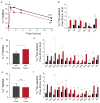Direct evidence for cancer-cell-autonomous extracellular protein catabolism in pancreatic tumors
- PMID: 28024083
- PMCID: PMC5407288
- DOI: 10.1038/nm.4256
Direct evidence for cancer-cell-autonomous extracellular protein catabolism in pancreatic tumors
Abstract
Mammalian tissues rely on a variety of nutrients to support their physiological functions. It is known that altered metabolism is involved in the pathogenesis of cancer, but which nutrients support the inappropriate growth of intact malignant tumors is incompletely understood. Amino acids are essential nutrients for many cancer cells that can be obtained through the scavenging and catabolism of extracellular protein via macropinocytosis. In particular, macropinocytosis can be a nutrient source for pancreatic cancer cells, but it is not fully understood how the tumor environment influences metabolic phenotypes and whether macropinocytosis supports the maintenance of amino acid levels within pancreatic tumors. Here we utilize miniaturized plasma exchange to deliver labeled albumin to tissues in live mice, and we demonstrate that breakdown of albumin contributes to the supply of free amino acids in pancreatic tumors. We also deliver albumin directly into tumors using an implantable microdevice, which was adapted and modified from ref. 9. Following implantation, we directly observe protein catabolism and macropinocytosis in situ by pancreatic cancer cells, but not by adjacent, non-cancerous pancreatic tissue. In addition, we find that intratumoral inhibition of macropinocytosis decreases amino acid levels. Taken together, these data suggest that pancreatic cancer cells consume extracellular protein, including albumin, and that this consumption serves as an important source of amino acids for pancreatic cancer cells in vivo.
Figures




Comment in
-
Pancreatic cancer: Pancreatic tumours derive amino acids via extracellular protein uptake.Nat Rev Gastroenterol Hepatol. 2017 Feb;14(2):68. doi: 10.1038/nrgastro.2017.3. Epub 2017 Jan 18. Nat Rev Gastroenterol Hepatol. 2017. PMID: 28096538 No abstract available.
References
MeSH terms
Substances
Grants and funding
LinkOut - more resources
Full Text Sources
Other Literature Sources
Medical
Molecular Biology Databases

